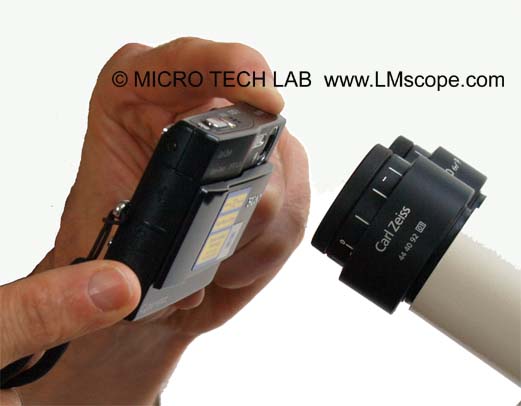

Photographing through a microscope eyepiece
In the simplest case, it is possible to take freehand images through a microscope eyepiece. Depending on the type of camera and lens used, with some samples, useable results may be achieved. Particularly for the hobbyist, if only a low quality photograph needs to be produced, then this method is worth a try!
Picture 1: Camera is held by hand over the eyepiece
Fundamentally, it is evident that compact cameras and camcorders with lenses with smaller front elements that are not telescopic are more suitable. The best results are provided by very small compact cameras whose lenses are integrated in the camera body. SLR camera lenses cause the most problems. These lenses mainly have larger maximum apertures and therefore have large diameter lens elements. This results in peripheral darkening and some aberrations. Due to the large number of lens elements in the lens unit the image quality is considerably reduced.
The greatest problem with freehand photography via a microscope is posed by motion blurring. Even when the hand is very steady, it will still move a few millimetres here and there. When pressing the shutter release button in particular, the camera is likely to shake. By using the shutter delay or self timer function on the camera, the shutter release is automatically delayed for a few seconds. This trick reduces blurring.
Finding the right position for the digital camera over the microscope’s optical axis is also not all that easy and can be quite arduous. Often it can take several minutes to find the optimum position.
Advantages of taking freehand photographs over the eyepiece:
• Unbeatable low price, as there is no optical adjustment between the microscope and the digital camera.
Disadvantages:
Long-winded, unergonomic search for the correct camera position over the microscope
- Motion blurring
- Peripheral darkening (vignetting)
- Serious image distortions No optical adaptation to the size of the digital camera’s sensor
Conclusion: If superior image quality and ease of use is important to you, then using an LM eyepiece adapter is the best solution. The best image quality is achieved by using a digital SLR camera with Live View function without a lens unit. Only the camera body is required. The LM digital adapter projects the image directly onto the camera’s sensor chip. No unnecessary lens elements will then be in the light path. The optimum LM digital adapter is used according to the size of the camera’s sensor.
Caution! This manual is protected by copyright. Unauthorised reproduction thereof, in whole or in part, is punishable by law. Only use with MICRO TECH LAB’s approval.
New LM Digital Adapter for: Nikon Z9 / Nikon Z8 / Sony Alpha 7R V / Sony Alpha 1 / Sony FX3 Cinema Line / Sony Alpha 9 II (ILCE-9M2) / Sony Alpha 9 / Nikon D6 / Canon EOS R3 / Canon EOS R6 Mark II / Canon EOS R8 / Sony Alpha 7R IV / Canon EOS R5 / Sony Alpha 7S II / Sony Alpha 7S III / Sony Alpha 7R III / Canon EOS R6 / Nikon Z6 / Nikon Z6II / Sony Alpha 7R II / Nikon Z7 / Nikon Z7II / Canon EOS R / Canon EOS Ra (Astro) / Nikon Z5 / Sony Alpha 7C / Canon EOS RP / Sony Alpha 7S / Canon EOS R7 / Leica SL2-S / Canon EOS R10 / Canon EOS 1D X Mark III / Nikon Z50 / Nikon Z30 / Nikon Z fc / Nikon D850 / Canon EOS 1D X Mark II / Nikon D780 / Olympus OM-1 / Sony Alpha 7III / Olympus OM-D E-M1 Mark III /
